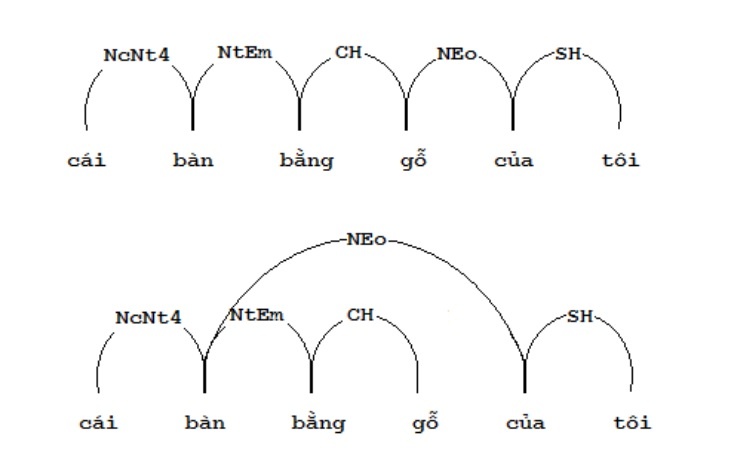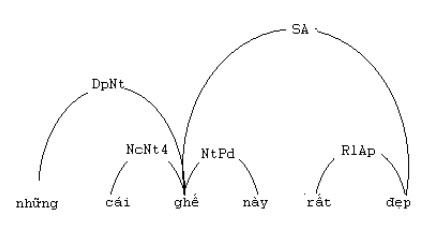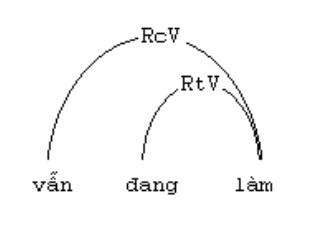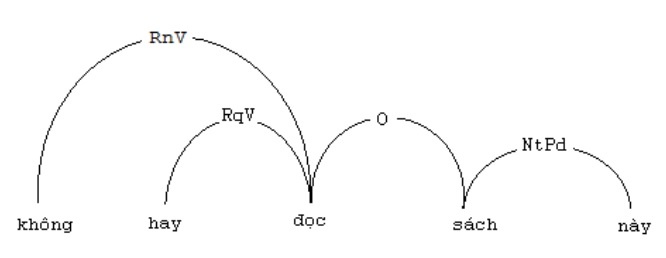In the case where both the 3rd and 4th subcomponents are present, ambiguity can occur as shown in Figure 2.6. In the first case the word “of” modifies “wood”, and in the second case the word “of” modifies “table”. This is a phrase that is both syntactically and semantically ambiguous. Both of these analyzes are correct. Which analysis is chosen depends on the context.

Figure 2.6. Two associations for the phrase “my wooden table”
- Nominative pronouns after the noun (position 2 or 4)
-Nouns with NtPd+ connections.
-Nominative pronouns with NtPd- connection.
For example, in the sentence “these chairs are beautiful” in figure 2.7 below

Figure 2.7. The links revolve around the central noun “chair”
c. Link nouns with prepositions
The link is established from the preposition to the noun (which can be the center of the noun), for example with the phrase “buy fish for this lazy cat”, the preposition “give” must be related to the noun. “cat”. The name of the link is EN+ for preposition, EN- for noun.
2.1.3. Links for verbs
Links for verbs are built in the same way as links with nouns. Based on the structure of the verb, conjunctions are also divided into two types: linking with the word standing to the left and linking with the word standing to the right of the main verb.
2.1.3.1. Verbs acting as predicate
If a noun and a pronoun that plays the role of a subject have an SV+ connection to the verb as the predicate (the main part of the predicate), then the verb has an SV- link to the subject.
In addition, only the relative verb ‘is’ has a DT_LA- link to the subject.
Verbs are also related to question words. Like the English linking dictionary, the question word links to the main verb of the sentence. Depending on the type of question word, it is usually at the beginning or the end of the sentence, but the link of the verb is THT or THS. When the question word already appears on the left side of the verb, it will not be possible for another question word to appear on the right. The formula for the verb shows this: THT- or THS+.
Links of words to ask:
why, why, who: THT+
where, how, right, what: THIS
Some other words can go before and after:
when, ever: THT+ or THS-
2.1.3.2. Link building based on verb structure
Similar to nouns, according to Nguyen Tai Can [2], there are different opinions about the main composition of verbs, especially in the case of two verbs that go together like “want to eat”. The thesis chooses the verb in front from the point of view of [2]. Thus, the identification of verb links based on verb structure is divided into two main branches: linking the main verb with the preceding auxiliary element and with the auxiliary element after (possibly another verb). .
- Link with the auxiliary element before the verb
The position before the verb is mainly reserved for the following types of auxiliary words:
- Comparative adverbs Rc (“also”, “even”, “still”, “still”, “still”, “forever”… ). Words within the group can be combined, for example “still the same”.
- Negative adverbs Rn (eg “no”, “no”, “yet”…), affirmative Ra (eg “certain”).
- Adverbs of time: past, present, future
These adverbs go with all types of verbs.
According to the summary of Nguyen Tai Can [2], the positions before the verbs of these auxiliary verbs can be summarized in the diagram of Figure 2.8 as follows:
| Comparative adverbs (Rc): even, also, still, every | Adverbs of time (Rt, Rp, Rf): used to, was, is, will | Negative auxiliary (Rn): no, no, not yet |
| Imperative Adverbs (Rm): don’t, don’t | Imperative Adverbs (Rm): don’t, don’t |
Maybe you are interested!
-
 Vietnamese linking grammar model - 8
Vietnamese linking grammar model - 8 -
 Links Of Nouns Act As Subject And Complement
Links Of Nouns Act As Subject And Complement -
 Vietnamese linking grammar model - 10
Vietnamese linking grammar model - 10 -
 Link Building Based On Adjective Structure
Link Building Based On Adjective Structure -
 Vietnamese linking grammar model - 13
Vietnamese linking grammar model - 13 -
 Application Algorithm To Expand Vietnamese Dictionary
Application Algorithm To Expand Vietnamese Dictionary
Figure 2.8. The auxiliary element precedes every verb
Links are established according to the diagram above for verbs:
{RnV-} &(({RtV- or RpV- or RfV-} & {@RcV-} ) or (RmV-))
Links are identified for the respective adverbs:
- Comparative adverbs: RcV+
- Negative Adverbs: RnV1+
- Imperative adverbs: RmV2+
- Time adverbs (past): RpV+
- Time adverbs (present): RtV+
- Time adverbs (future): RfV+
Example: The link of the phrase “still working” in figure 2.9.

Figure 2.9. Links in the phrase “still working”
In addition, some other types of auxiliary verbs are also able to combine with all verbs:
- Range adverbs (subtype Rs, e.g. “only”): Adverbs of this type can come after a comparative or a future time adverb.
– Linking formula for verb: RsV- &{RcV- or RfV-}
– Linking formula for range adverbs: RsV+
- Adverbs of frequency (subtype Rq, eg “usually”, “or”, “power”): Adverbs of this type can precede a range adverb, or follow a comparative. Only negative adverbs can go before or after adverbs of frequency. Each position has a different meaning.
Words belonging to this group can be combined with each other within the group, for example “usually”
Linking formula for verb: {RcV-or RnV-} & @RqV- & {RsV- or RnV-}
For example, the links for the phrase “don’t read this book often” are shown in Figure 2.10 below:

Figure 2.10. Links in the phrase “don’t read this book often”
- Affirmative adverbs (subtype Ra, e.g. “certain”): Unlike negative adverbs, affirmative adverbs precede adverbs of time if both modify the same verb.
Linking formula for verb: {RaV-}&{RtV- or RpV- or RfV-}
Linking formula for adverb: RaV+
- Link with the auxiliary element after the verb






